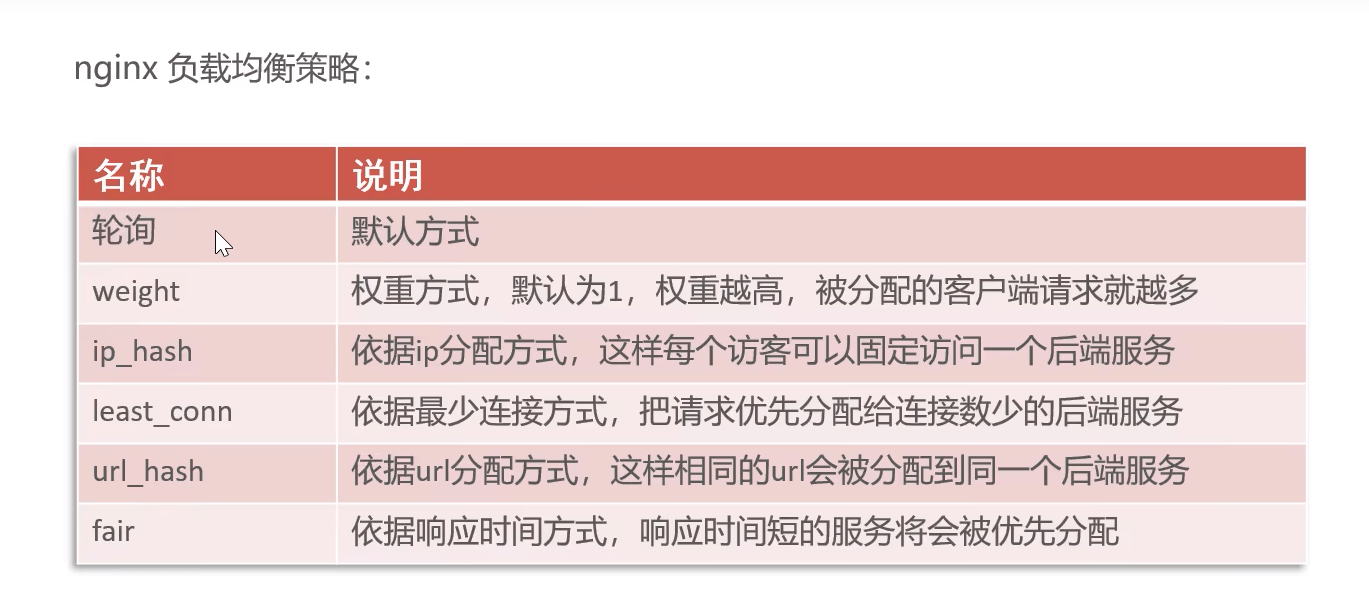Nginx配置反向代理和负载均衡
配置反向代理:
# 反向代理,处理管理端发送的请求
location /api/ {
proxy_pass http://localhost:8080/admin/;
#proxy_pass http://webservers/admin/;
}上面的代码会将当前服务器请求的/api/请求转发到localhost:8080/admin/
地址上去
配置负载均衡:
1,首先配置需要参与负载均衡的服务器地址
upstream webservers{
server 127.0.0.1:8080 weight=90 ;
server 127.0.0.1:8088 weight=10 ;
}2,再配置反向代理进行转发
location /api/ {
#proxy_pass http://webservers/admin/;
}系统就会自动将对应的api请求转发到upstream上面配置的两台服务器上面,注意
webservers一定要保持一致

参考代码:

示例代码如下:
#user nobody;
worker_processes 1;
#error_log logs/error.log;
#error_log logs/error.log notice;
#error_log logs/error.log info;
#pid logs/nginx.pid;
events {
worker_connections 1024;
}
http {
include mime.types;
default_type application/octet-stream;
#log_format main '$remote_addr - $remote_user [$time_local] "$request" '
# '$status $body_bytes_sent "$http_referer" '
# '"$http_user_agent" "$http_x_forwarded_for"';
#access_log logs/access.log main;
sendfile on;
#tcp_nopush on;
#keepalive_timeout 0;
keepalive_timeout 65;
#gzip on;
map $http_upgrade $connection_upgrade{
default upgrade;
'' close;
}
upstream webservers{
server 127.0.0.1:8080 weight=90 ;
#server 127.0.0.1:8088 weight=10 ;
}
server {
listen 80;
server_name localhost;
#charset koi8-r;
#access_log logs/host.access.log main;
location / {
root html/sky;
index index.html index.htm;
}
#error_page 404 /404.html;
# redirect server error pages to the static page /50x.html
#
error_page 500 502 503 504 /50x.html;
location = /50x.html {
root html;
}
# 反向代理,处理管理端发送的请求
location /api/ {
proxy_pass http://localhost:8080/admin/;
#proxy_pass http://webservers/admin/;
}
# 反向代理,处理用户端发送的请求
location /user/ {
proxy_pass http://webservers/user/;
}
# WebSocket
location /ws/ {
proxy_pass http://webservers/ws/;
proxy_http_version 1.1;
proxy_read_timeout 3600s;
proxy_set_header Upgrade $http_upgrade;
proxy_set_header Connection "$connection_upgrade";
}
# pass the PHP scripts to FastCGI server listening on 127.0.0.1:9000
#
#location ~ \.php$ {
# root html;
# fastcgi_pass 127.0.0.1:9000;
# fastcgi_index index.php;
# fastcgi_param SCRIPT_FILENAME /scripts$fastcgi_script_name;
# include fastcgi_params;
#}
# deny access to .htaccess files, if Apache's document root
# concurs with nginx's one
#
#location ~ /\.ht {
# deny all;
#}
}
# another virtual host using mix of IP-, name-, and port-based configuration
#
#server {
# listen 8000;
# listen somename:8080;
# server_name somename alias another.alias;
# location / {
# root html;
# index index.html index.htm;
# }
#}
# HTTPS server
#
#server {
# listen 443 ssl;
# server_name localhost;
# ssl_certificate cert.pem;
# ssl_certificate_key cert.key;
# ssl_session_cache shared:SSL:1m;
# ssl_session_timeout 5m;
# ssl_ciphers HIGH:!aNULL:!MD5;
# ssl_prefer_server_ciphers on;
# location / {
# root html;
# index index.html index.htm;
# }
#}
}
本作品采用《CC 协议》,转载必须注明作者和本文链接




 关于 LearnKu
关于 LearnKu




推荐文章: